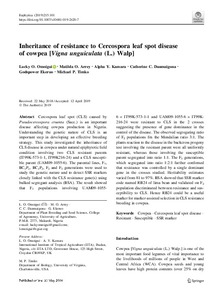| dc.contributor.author | Omoigui, L. |
| dc.contributor.author | Arrey, M.O. |
| dc.contributor.author | Kamara, A. |
| dc.contributor.author | Danmaigona, C.C. |
| dc.contributor.author | Ekeruo, G. |
| dc.contributor.author | Timko, M.P. |
| dc.date.accessioned | 2019-12-04T11:33:49Z |
| dc.date.available | 2019-12-04T11:33:49Z |
| dc.date.issued | 2019-05-03 |
| dc.identifier.citation | Omoigui, L., Arrey, M.O., Danmaigona, C.C., Ekeruo, G. & Timko, M.P. (2019). Inheritance of resistance to Cercospora leaf spot disease of cowpea [Vigna unguiculata (L.) Walp]. Euphytica, 215(5): 101, 1-12. |
| dc.identifier.issn | 0014-2336 |
| dc.identifier.uri | https://hdl.handle.net/20.500.12478/5819 |
| dc.description | Open Access Article |
| dc.description.abstract | Cercospora leaf spot (CLS) caused by Pseudocercospora cruenta (Sacc.) is an important disease affecting cowpea production in Nigeria. Understanding the genetic nature of CLS is an important step in developing an effective breeding strategy. This study investigated the inheritance of CLS disease in cowpea under natural epiphytotic field condition involving two CLS resistant parents (IT99K-573-1-1, IT99K216-24) and a CLS susceptible parent (UAM09-1055-6). The parental lines, F1, BC1P1, BC1P2, F2 and F3 generations were used to study the genetic nature and to detect SSR markers closely linked with the CLS resistance gene(s) using bulked segregant analysis (BSA). The result showed that F1 populations involving UAM09-1055-6 × IT99K-573-1-1 and UAM09-1055-6 × IT99K-216-24 were resistant to CLS in the 2 crosses suggesting the presence of gene dominance in the control of the disease. The observed segregating ratio of F2 populations fits the Mendalian ratio 3:1. The plants reaction to the disease in the backcross progeny test involving the resistant parent were all uniformly resistant, whereas those involving the susceptible parent segregated into ratio 1:1. The F3 generations, which segregated into ratio 1:2:1 further confirmed that resistance was controlled by a single dominant gene in the crosses studied. Heritability estimates varied from 81 to 97%. BSA showed that SSR marker code named RB24 of lima bean and validated on F2 population discriminated between resistance and susceptibility to CLS. Hence RB24 could be a useful marker for marker-assisted selection in CLS resistance breeding in cowpea. |
| dc.description.sponsorship | Kirkhouse Trust |
| dc.format.extent | 1-12 |
| dc.language.iso | en |
| dc.rights | CC-BY-4.0 |
| dc.subject | Cowpeas |
| dc.subject | Cercospora |
| dc.subject | Leaf Spots |
| dc.subject | Disease Resistance |
| dc.subject | Ssrna Viruses |
| dc.title | Inheritance of resistance to Cercospora leaf spot disease of cowpea [Vigna unguiculata (L.) Walp] |
| dc.type | Journal Article |
| dc.description.version | Peer Review |
| cg.contributor.crp | Grain Legumes |
| cg.contributor.affiliation | International Institute of Tropical Agriculture |
| cg.contributor.affiliation | University of Agriculture, Makurdi |
| cg.contributor.affiliation | University of Virginia |
| cg.coverage.region | Africa |
| cg.coverage.region | West Africa |
| cg.coverage.country | Nigeria |
| cg.creator.identifier | Lucky Omoigui: 0000-0001-8473-2775 |
| cg.creator.identifier | Alpha Kamara: 0000-0002-1844-2574 |
| cg.researchtheme | BIOTECH & PLANT BREEDING |
| cg.isijournal | ISI Journal |
| cg.authorship.types | CGIAR and developing country institute |
| cg.iitasubject | Plant Breeding |
| cg.iitasubject | Plant Diseases |
| cg.journal | Euphytica |
| cg.howpublished | Formally Published |
| cg.accessibilitystatus | Open Access |
| local.dspaceid | 105272 |
| cg.targetaudience | Scientists |
| cg.identifier.doi | https://dx.doi.org/10.1007/s10681-019-2420-7 |

